Kristina Killgrove
Source - http://www.forbes.com/sites/kristinakillgrove/2015/07/25/skeletons-of-napoleons-soldiers-in-mass-grave-show-signs-of-starvation/
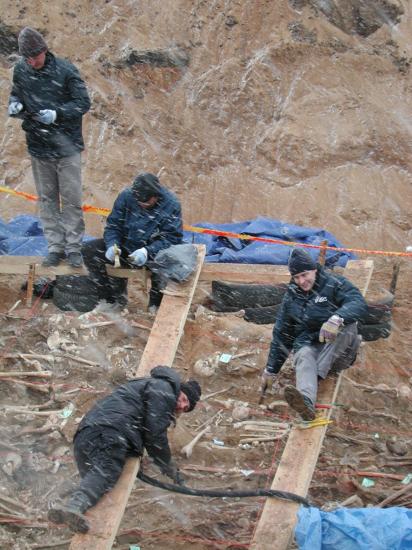 Lithuanian archaeologists brave the snow to excavate a Napoleonic mass grave in Vilnius. (Image used with kind permission of Rimantas Jankauskas)
Lithuanian archaeologists brave the snow to excavate a Napoleonic mass grave in Vilnius. (Image used with kind permission of Rimantas Jankauskas)
As snow lashed across their faces, archaeologists quickly excavated a mass grave in Vilnius, Lithuania. The jumbled bones, haphazardly oriented, were punctuated with finds of shoes, clothing, and armor. Buttons revealed the identity of the dead: over 40 different regiments were represented, all from Napoleon’s Grande Armée. Archaeologists had found the final resting place of over three thousand men who perished during Napoleon’s retreat from Moscow in 1812. Now, new chemical analyses of the bones are revealing where these soldiers hailed from and just how difficult it was to find enough to eat.
Napoleon’s exploits are well-known from history. In an attempt to prevent invasion of Poland by Russian Czar Alexander I, Napoleon decided to invade Russia first. He started out with around 675,000 men who came from all over Europe; French, Germans, Polish, Lithuanians, Spanish, and Italians, however, made up the majority. This Grande Armée dwindled on its advance to Russia, then retreated when the czar refused to surrender and there were no supplies for the army in Moscow. By the time the army got to Smolensk, Russia, there were just 41,000 soldiers remaining. Charles Minard, a 19th century engineer who pioneered the creation of infographics, famously depicted just how treacherous this campaign was and what the loss of life looked like.
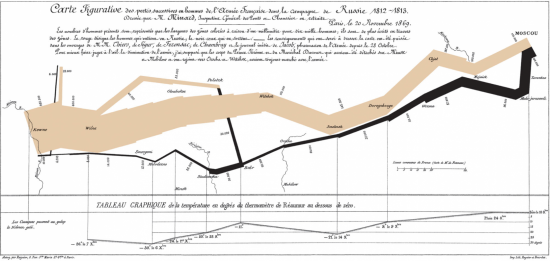 Figurative Map of the successive losses in men of the French Army in the Russian campaign 1812-1813.
Figurative Map of the successive losses in men of the French Army in the Russian campaign 1812-1813.
Drawn up by M. Minard, Inspector General of Bridges and Roads in retirement. Paris, November 20, 1869.
The numbers of men present are represented by the widths of the colored zones at a rate of one millimeter for every ten-thousand men; they are further written across the zones. The brown designates the men who enter into Russia, the black those who leave it. (Public domain image via wikimedia commons)
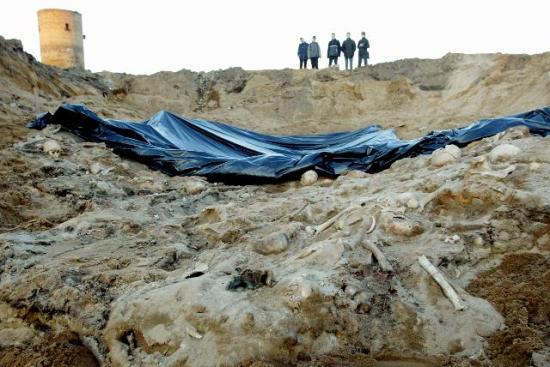 Local residents look at bones in a mass grave where bodies of Napoleon-era French soldiers were found in a suburb of the Lithuanian capital Vilnius, Friday, March 15, 2002. The mass garve containing as many as 2,000 French soldiers who fought for Napoleon Bonaparte during the War of 1812 has been unearthed in a Vilnius suburb. The site was discovered by construction workers. (AP Photo/Mindaugas Kulbis)
Local residents look at bones in a mass grave where bodies of Napoleon-era French soldiers were found in a suburb of the Lithuanian capital Vilnius, Friday, March 15, 2002. The mass garve containing as many as 2,000 French soldiers who fought for Napoleon Bonaparte during the War of 1812 has been unearthed in a Vilnius suburb. The site was discovered by construction workers. (AP Photo/Mindaugas Kulbis)
The Grande Armée continued west, crossed the Beresina River, and arrived in Vilnius. But there was little to eat there either. Around 20,000 soldiers died in Vilnius of hypothermia, starvation, and typhus. Corpses were thrown into mass graves. One of these, containing the remains of at least 3,269 people, was excavated by bioarchaeologist Rimantas Jankauskas and his team in just one month in 2001. Bodies were packed seven to a square meter, tossed in with clothing and other items. Based on the bones, archaeologists found that almost all the dead were males, with the exception of two dozen females, and that most were in their 20s at death.
Two new research studies on these remains have attempted to answer questions about soldiers’ homelands and their diet leading up to their deaths. University of Central Florida anthropology students Serenela Pelier and Sammantha Holder, under the direction of UCF bioarchaeologist Tosha Dupras, performed stable isotope analyses on samples of the remains. Pelier used oxygen isotopes to find out the geographical origin of nine of the skeletons, while Holder used carbon and nitrogen isotopes to learn about diet and starvation.
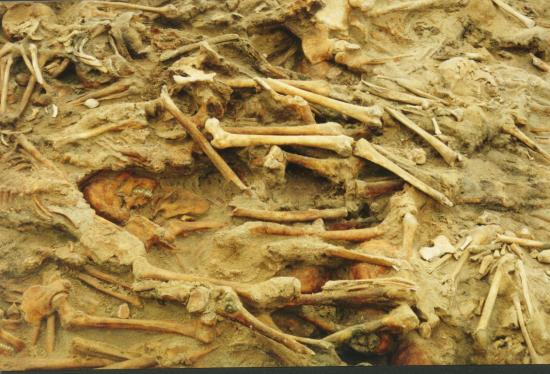 Photo taken during excavation of the Napoleonic mass grave in Vilnius. (Image used with kind permission of Rimantas Jankauskas)
Photo taken during excavation of the Napoleonic mass grave in Vilnius. (Image used with kind permission of Rimantas Jankauskas)
Pelier took samples from the femur of eight males and one female for oxygen isotope analysis. Oxygen isotopes in the biosphere vary depending on factors like humidity, distance from the sea, and elevation. By measuring the oxygen isotopes in human bone, it is possible to learn whether that individual was born in a particular geographic area. Pelier found that none of the individuals she tested had oxygen values that would be expected for Vilnius; no one was local. Based on the much higher oxygen values, they were more likely from central and western Europe, with three individuals possibly from the Iberian peninsula and one who may have participated in an African campaign before the Russian one. Additionally, the one woman who was tested may have hailed from southern France.
Holder also took samples from the femur of 73 males and three females buried in the mass grave, and she performed an analysis of the stable carbon and nitrogen isotopes in the bone. While carbon isotopes provide information mainly about the carbohydrate portion of the diet, nitrogen isotopes can give data on the protein component. Holder found that most of Napoleon’s soldiers were eating plants like wheat, while a few may have come from areas like Italy where more millet was consumed. The carbon isotopes did not hold any surprises.
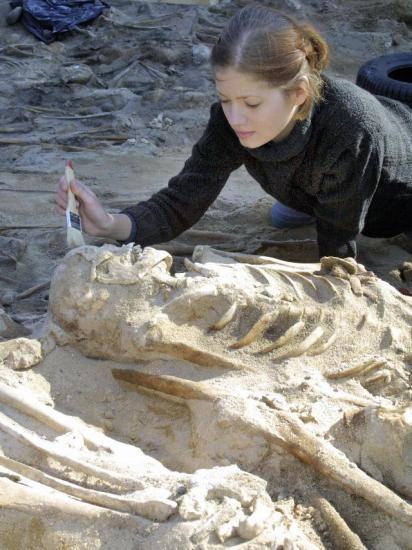 File picture dated autumn 2001 shows a researcher examining skeletons of the Napoleonic soldiers discovered in a mass grave on a building site. Burial ceremonies were held at the Antakalnis memorial graveyard 01 June 2003 of remains of 3,000 French soldiers, slain in 1812 as Napoleon Bonaparte’s army fled in defeat from Russia, and finally laid to rest almost two centuries after they died. (Photo credit should read PETRAS MALUKAS/AFP/Getty Images
File picture dated autumn 2001 shows a researcher examining skeletons of the Napoleonic soldiers discovered in a mass grave on a building site. Burial ceremonies were held at the Antakalnis memorial graveyard 01 June 2003 of remains of 3,000 French soldiers, slain in 1812 as Napoleon Bonaparte’s army fled in defeat from Russia, and finally laid to rest almost two centuries after they died. (Photo credit should read PETRAS MALUKAS/AFP/Getty Images
But Holder was much more interested in the nitrogen isotopes. More than two dozen of the people she sampled had high nitrogen values. Often, this is an indication that someone was eating high on the food chain, as nitrogen levels are higher in carnivorous animals compared to herbivores. Holder suspected, though, that something else was going on with these soldiers. When the human body is deprived of protein, nitrogen isotope values can skyrocket. So conditions like anorexia, prolonged morning sickness, vitamin D deficiency, and starvation can cause an increase in nitrogen signatures.
PART.2